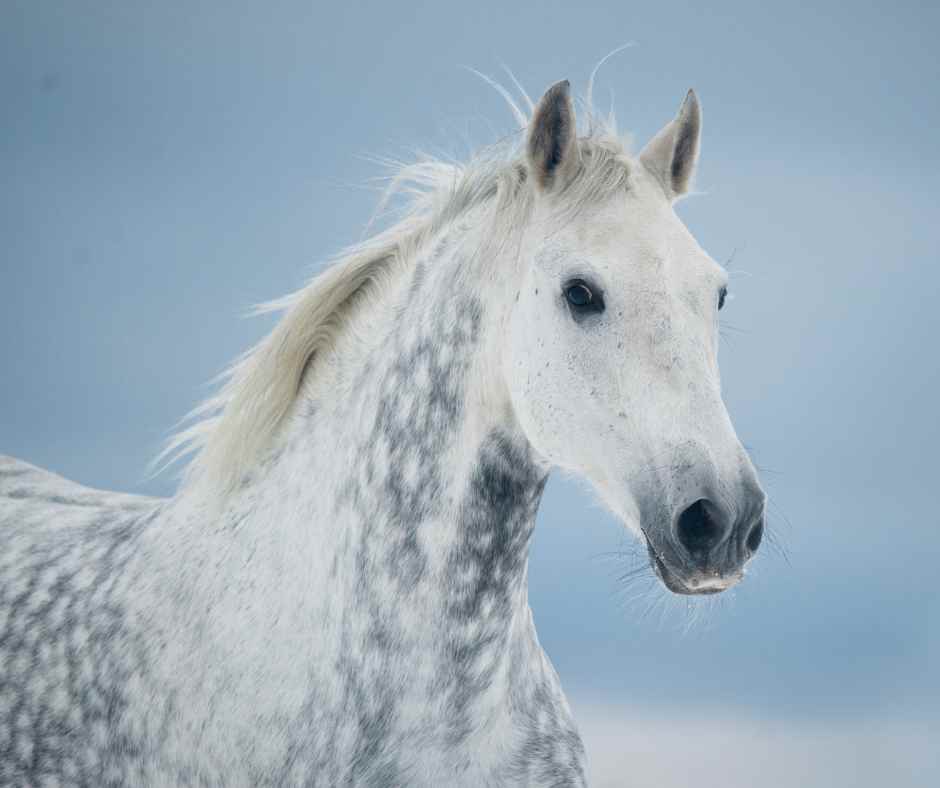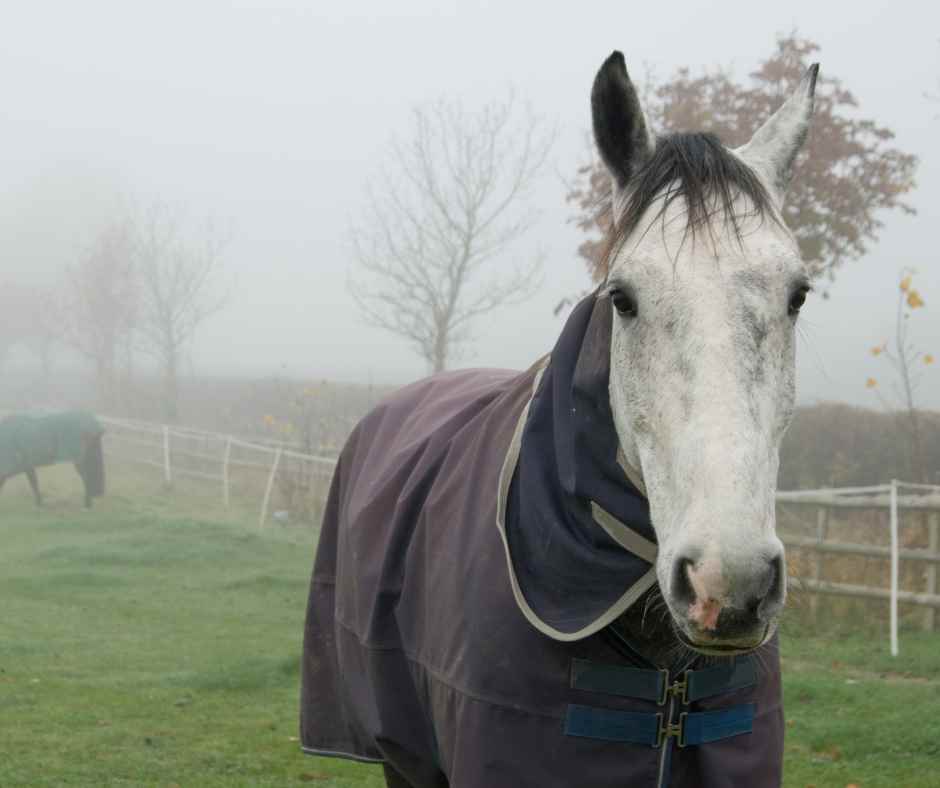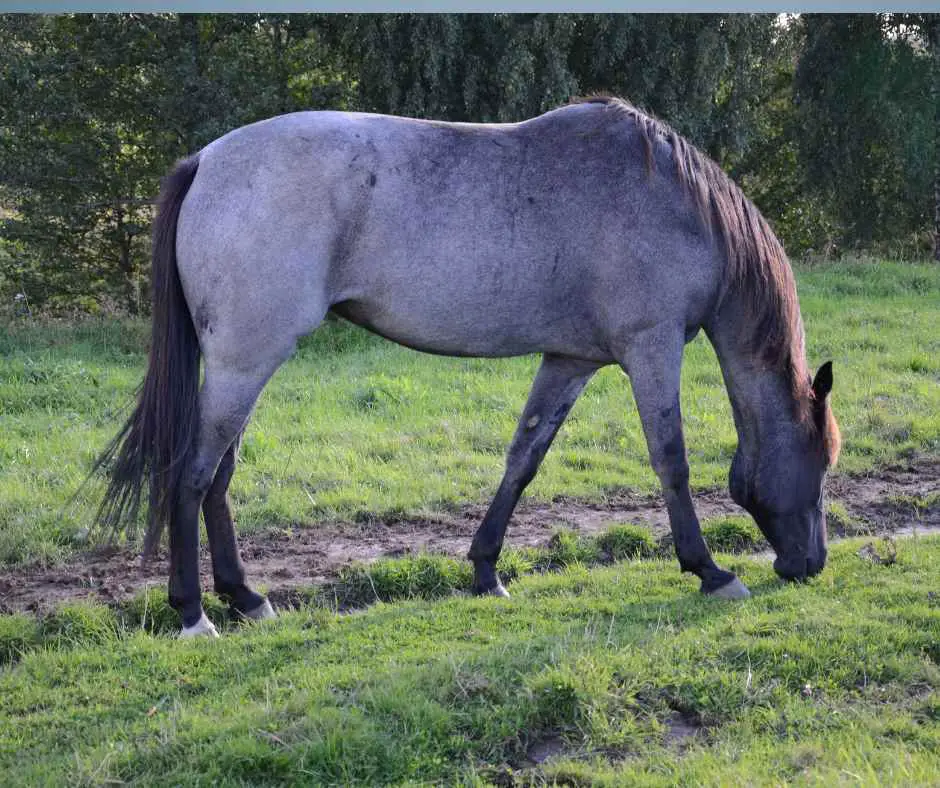Maintaining a grey horse’s cleanliness in the winter can be challenging. Of course, that’s due to the cold, wet, and muddy conditions. But you cannot leave the horse uncleaned either. Thus, the questions arise: how to keep a grey horse clean in winter? how to clean a grey horse’s tail?

Indeed, it’s not impossible to keep a grey horse looking clean and healthy, even in the winter months. With a bit of extra care, you can do so! There are also some techniques for keeping a four-legged animal tidied in the cold. By following those methods, your horse will look clean throughout the winter season.
Ways of how to clean a grey horse in winter
The following are six important methods to keep a grey horse clean in winter;
Currying
Currying is one of the ways to remove dirt from your horse in cold weather. It involves grooming and caring for the horse’s coat with a curry comb. A curry comb with long fingers is better than a traditional one with short, oval-shaped teeth.
That’s because the former reaches through a long winter coat more effectively than the latter.
To curry a horse in winter, gently use the comb to loosen dirt and tangles from the horse’s coat. Next, use the stiff-bristled brush to remove any remaining dirt and messes. Then, use the soft-bristled brush to smooth the skin and loose hair. Be sure to focus specifically on areas like the legs, underbelly, and tail. These are the places where dirt and tangles can quickly accumulate.
Besides removing dirt, currying also massages the horse’s skin and distributes natural oils. It also keeps the four-legged animal healthy. For instance, currying helps to improve a horse’s circulation.
Moreover, being gentle and patient is essential when carrying an equine. You should stop if the horse seems uncomfortable or distressed. It’s also good to check the equine’s skin for cuts or abrasions. Also, be cautious around sensitive areas like the face and legs.
In addition, if you’re new to horse care, it may be helpful to seek guidance from a professional groomer.
Trimming a Horse
Trimming is another way that helps to keep your grey horse clean in the winter months. For trimming fetlocks and feathers, use a pair of sharp scissors. Fetlocks are the area just above the hooves, while feathering is the long hair on the equine’s lower legs.
Also, some horses have hair all over their hooves. However, feathers are not present in all breeds.
It is also essential to note that you should only consider cutting hair on fetlocks if they are long. Furthermore, trimming around the hooves is significant because it prevents dirt and mud from accumulating on the bottom of the feet. It also keeps the horse’s hair from getting matted or caked with mud.
Moreover, how to clean a grey horse’s tail and mane? Trimming is the answer to this query as well. First, trim them back slightly to make the hair easily brushable. Next, use thinning shears or a blunt-tipped pair of scissors to gently thin out the hair. Consequently, the tail and mane look fine.
Also, use caution when cutting an equine’s hair; be careful not to cut too near the skin while trimming. That’s because its skin is thin and delicate.
Hot toweling Your Grey Horse
How to keep a grey horse clean in winter? Hot toweling is one way to do it, especially when the dirt is difficult to remove with regular grooming. In addition, it allows you to deep clean your equine’s coat and skin when it is too cold for a full bath.
However, before starting the process of steam cleaning, follow the below-mentioned three steps;
- Gather your supplies: You will need a submersible heater or portable kettle, a bucket of warm water, and a towel for steam cleaning.
- Prepare the horse: Ensure the horse is groomed and free of any visible dirt before hot toweling.
- Heat the water: Heat the bucket using a submersible heater or portable kettle. The water should not be hot to the extent that placing your gloved hand in it becomes uncomfortable.
After finishing the first three steps, you can now begin steam cleaning. Start by dipping a clean towel in hot water. Then wring it out until it is nearly dry. Next, to clean the horse’s coat, vigorously rub a damp towel against the direction of the hair growth in small sections.
As the towel becomes dirty, switch to a clean part of it. When the towel stops producing steam, redip it in hot water. Then wring it out again. You may need to use several large bath towels to clean the entire horse and a smaller hand towel for the face.
After you complete the steam cleaning process, use a dry towel to remove excess water from the equine’s coat.
In addition, if the horse becomes damp during cleaning, it’s essential to keep it covered with a cooler or warm, dry blanket. That prevents the four-legged animal from getting chilled. A chilled horse may become uncomfortable and be more prone to developing health issues such as respiratory infections.
Using protective Horse blankets

Wet and muddy conditions in winter make it difficult to clean a grey horse. However, protective blankets or sheets can help. Nonetheless, remember a few things as you blanket your animal.
First, choose a protective blanket or sheet that is the appropriate size for your horse. It should be large enough to cover the horse’s entire body and fit snugly. Secondly, look for a blanket made from a waterproof material, such as nylon or polyester.
It will help to keep the horse’s coat dry. Moreover, when you bring the equine back inside, don’t forget to remove the sheet.
Drawing a horse’s blanket in the winter allows for proper inspection and grooming. For example, you can check the horse’s weight after removing the sheet that will be otherwise hidden. It’s necessary to do so because, in winter, the animal may be burning more calories to stay warm.
Thus, it loses weight quickly, which must be addressed.
Finally, removing the sheet also allows you to look for any injuries or infections – that remain hidden – beneath the blanket.
Keeping the horse in a clean environment
How to keep a grey horse clean in winter? Keeping the horse in a clean environment is one of the ways to do so! It not only maintains the horse’s cleanliness in winter but also cuts down on its grooming time. Thus, to pervert the horse from getting dirty, reduce its contact with the following:
- manure and urine
- freshly mowed, wet, or very lush grass
- mud
Moreover, ensure to clean the horse’s stable or barn regularly. That removes any dirt that may accumulate there and keep the environment hygienic. As a result, the horse’s coat will remain clean as well.
Furthermore, use clean, dry bedding in the stable or barn to prevent the equine’s body from getting wet and muddy. Also, avoid turning the horse into muddy pastures during the winter months.
Lastly, keep the pasture grass trimmed. That helps to avoid the grass getting stuck to the equine’s coat and keep it tidy.
Dirt defense for leg markings
Using a chalk-based product can keep a grey horse’s white leg markings clean in the winter. It is a technique that traditional horsemen and women have used for many years. However, looking for a product specifically formulated for horse use is important. Plus, avoid low-quality items.
That will help ensure the product is safe and effective for the four-legged animal.
You can apply the chalk-based product on the horse by mixing it with water. As a result, a paste may be created. Apply that paste to the white markings with a brush or sponge. Then, cover them with stable bandages.

That will help keep the paste in place and protect the socks and stockings from getting dirty or wet. In the morning, unwrap the stable bandages and brush off any excess paste to uncover clean white leg markings.
Moreover, you can also use a silicon product, such as a conditioner containing silicone, for horse socks and stockings. However, before spraying on the conditioner, thoroughly clean and dry the white leg markings. That will help remove any dirt or debris present and allow the conditioner to be more effective.
Once the leg markings are clean and dry, spray on the silicone conditioner. The spray coats the hair shafts, making them so slick that dirt slides right off. Also, ensure to read the instructions provided by the manufacturer before applying the silicone product.
So, how to keep a grey horse clean in winter is no longer a mystery. You can make your equine look fresh and tidy even on cold days by diligently following the methods mentioned in this article. In conclusion, the cleaning methods are a combination of grooming techniques and cautionary measures.
Nevertheless, it may feel hard to follow the processes like trimming, hot-toweling, etc. Yet, guidance from an experienced owner or professional help can solve the problem. Hence, making the cleanliness of your horse in winter months possible now.

